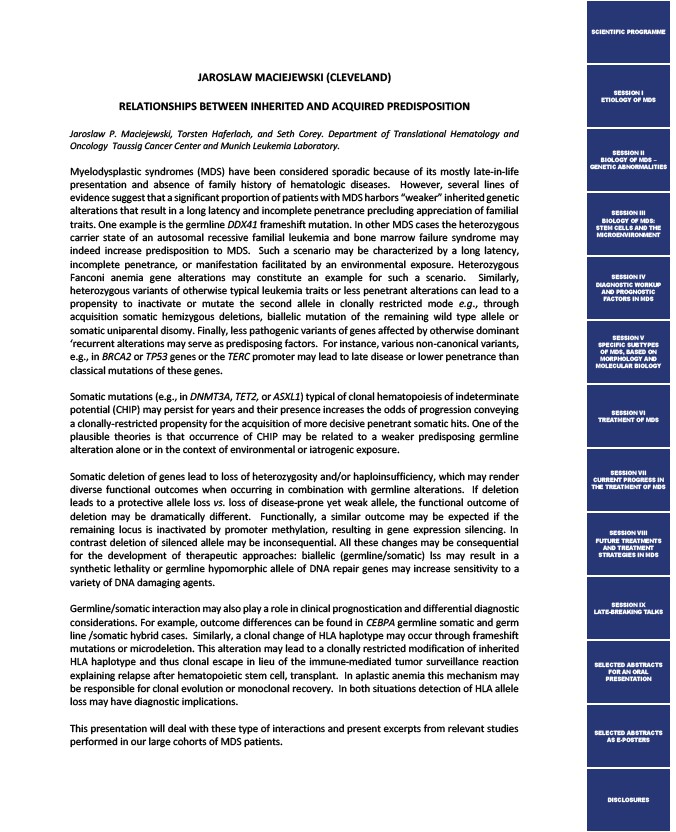
JAROSLAW MACIEJEWSKI (CLEVELAND)
RELATIONSHIPS BETWEEN INHERITED AND ACQUIRED PREDISPOSITION
Jaroslaw P. Maciejewski, Torsten Haferlach, and Seth Corey. Department of Translational Hematology and
Oncology Taussig Cancer Center and Munich Leukemia Laboratory.
Myelodysplastic syndromes (MDS) have been considered sporadic because of its mostly late-in-life
presentation and absence of family history of hematologic diseases. However, several lines of
evidence suggest that a significant proportion of patients with MDS harbors “weaker” inherited genetic
alterations that result in a long latency and incomplete penetrance precluding appreciation of familial
traits. One example is the germline DDX41 frameshift mutation. In other MDS cases the heterozygous
carrier state of an autosomal recessive familial leukemia and bone marrow failure syndrome may
indeed increase predisposition to MDS. Such a scenario may be characterized by a long latency,
incomplete penetrance, or manifestation facilitated by an environmental exposure. Heterozygous
Fanconi anemia gene alterations may constitute an example for such a scenario. Similarly,
heterozygous variants of otherwise typical leukemia traits or less penetrant alterations can lead to a
propensity to inactivate or mutate the second allele in clonally restricted mode e.g., through
acquisition somatic hemizygous deletions, biallelic mutation of the remaining wild type allele or
somatic uniparental disomy. Finally, less pathogenic variants of genes affected by otherwise dominant
‘recurrent alterations may serve as predisposing factors. For instance, various non-canonical variants,
e.g., in BRCA2 or TP53 genes or the TERC promoter may lead to late disease or lower penetrance than
classical mutations of these genes.
Somatic mutations (e.g., in DNMT3A, TET2, or ASXL1) typical of clonal hematopoiesis of indeterminate
potential (CHIP) may persist for years and their presence increases the odds of progression conveying
a clonally-restricted propensity for the acquisition of more decisive penetrant somatic hits. One of the
plausible theories is that occurrence of CHIP may be related to a weaker predisposing germline
alteration alone or in the context of environmental or iatrogenic exposure.
Somatic deletion of genes lead to loss of heterozygosity and/or haploinsufficiency, which may render
diverse functional outcomes when occurring in combination with germline alterations. If deletion
leads to a protective allele loss vs. loss of disease-prone yet weak allele, the functional outcome of
deletion may be dramatically different. Functionally, a similar outcome may be expected if the
remaining locus is inactivated by promoter methylation, resulting in gene expression silencing. In
contrast deletion of silenced allele may be inconsequential. All these changes may be consequential
for the development of therapeutic approaches: biallelic (germline/somatic) lss may result in a
synthetic lethality or germline hypomorphic allele of DNA repair genes may increase sensitivity to a
variety of DNA damaging agents.
Germline/somatic interaction may also play a role in clinical prognostication and differential diagnostic
considerations. For example, outcome differences can be found in CEBPA germline somatic and germ
line /somatic hybrid cases. Similarly, a clonal change of HLA haplotype may occur through frameshift
mutations or microdeletion. This alteration may lead to a clonally restricted modification of inherited
HLA haplotype and thus clonal escape in lieu of the immune-mediated tumor surveillance reaction
explaining relapse after hematopoietic stem cell, transplant. In aplastic anemia this mechanism may
be responsible for clonal evolution or monoclonal recovery. In both situations detection of HLA allele
loss may have diagnostic implications.
This presentation will deal with these type of interactions and present excerpts from relevant studies
performed in our large cohorts of MDS patients.
SCIENTIFIC PROGRAMME
SESSION I
ETIOLOGY OF MDS
SESSION II
BIOLOGY OF MDS –
GENETIC ABNORMALITIES
SESSION III
BIOLOGY OF MDS:
STEM CELLS AND THE
MICROENVIRONMENT
SESSION IV
DIAGNOSTIC WORKUP
AND PROGNOSTIC
FACTORS IN MDS
SESSION V
SPECIFIC SUBTYPES
OF MDS, BASED ON
MORPHOLOGY AND
MOLECULAR BIOLOGY
SESSION VI
TREATMENT OF MDS
SESSION VII
CURRENT PROGRESS IN
THE TREATMENT OF MDS
SESSION VIII
FUTURE TREATMENTS
AND TREATMENT
STRATEGIES IN MDS
SESSION IX
LATE-BREAKING TALKS
SELECTED ABSTRACTS
FOR AN ORAL
PRESENTATION
SELECTED ABSTRACTS
AS E-POSTERS
DISCLOSURES